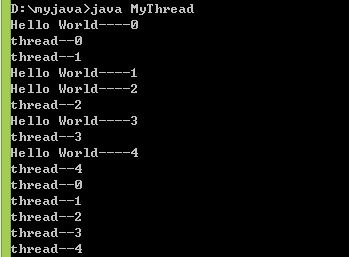一、内部类
1、内部类
代码:InnerClassDemo.java
/*
内部类的访问规则:
1、内部类可以直接访问外部类中的成员,包括私有。
之所以可以直接访问外部类中的成员,是因为内部类中持有了一个外部类的引用,格式 外部类名.this
2、外部类要访问内部类,必须建立内部类对象。
*/
class Outer
{
private int x = 3;
class Inner //内部类
{
int x = 4;
void function()
{
int x = 6;
System.out.println("inner:" + x); //得6,内部有就不出去找
System.out.println("inner:" + this.x); //得4
System.out.println("inner:" + Outer.this.x); //得3
}
}
void method()
{
Inner in = new Inner();
in.function();
}
}
class InnerClassDemo
{
public static void main(String[] args)
{
//Outer out = new Outer();
//out.method(); //得inner:3
//直接访问内部类中的成员
Outer.Inner in = new Outer().new Inner(); //一个格式,防止面试的,一般用不到,因为内部类一般都私有了
in.function();
}
}代码:InnerClassDemo2.java
/*
访问格式:
1、当内部类定义在外部类的成员位置上,而且非私有,可以在外部其他类中。
可以直接建立内部类对象。
格式
外部类名.内部类名 变量名 = 外部类对象.内部类对象;
Outer.Inner in = new Outer().new Inner();
2、当内部类在成员位置上,就可以被成员修饰符所修饰。 (不做重点掌握,要知道。开发一般不写)
比如,private:将内部类在外部类中进行封装。
static:内部类就具备static的特性。
当内部类被static修饰后,只能直接访问外部类中的static成员。出现了访问局限。
在外部其他类中,如何直接访问static内部类的非静态成员呢:
new Outer.Inner().function();
在外部其他类中,如何直接访问static内部类的静态成员呢:
Outer.Inner.function(); //这种方式使用频率很低
注意:当内部类中定义了静态成员,该内部类必须是static的。
当外部类中的静态方法访问内部类时,内部类也必须是static的。
*/
class Outer
{
private static int x = 3;
static class Inner //静态内部类
{
static void function()
{
System.out.println("inner:" + x);
}
}
static class Inner2
{
void show()
{
System.out.println("inner2 show");
}
}
public static void method()
{
Inner.function();
new Inner2().show();
}
}
class InnerClassDemo2
{
public static void main(String[] args)
{
Outer.method();
}
}/*
当描述事物时,事物的内部还有事物,该事物用内部类来描述。
因为内部事务在使用外部事物的内容。
class Body
{
private class XinZang
{
}
public void show()
{
new XinZang().
}
}
*/代码:InnerClassDemo3.java
/*
内部类定义在局部时,
1、不可以被成员修饰符修饰
2、可以直接访问外部类中的成员,因为还持有外部类中的引用。
但是不可以访问它所在的局部中的变量。只能访问被final修饰的局部变量。
*/
class Outer
{
int x = 3;
void method(final int a)
{
final int y = 4;
class Inner
{
void function()
{
System.out.println(a);
}
}
new Inner().function();
}
}
class InnerClassDemo3
{
public static void main(String[] args)
{
Outer out = new Outer();
out.method(7); //得7
out.method(8); //得8 为什么a被final修饰了,还能被改变
}
}
2、匿名内部类:
代码:InnerClassDemo4.java
/*
匿名内部类:
1,匿名内部类其实就是内部类的简写格式。
2,定义匿名内部类的前提:
内部类必须是继承一个类或者实现接口。
3,匿名内部类的格式: new 父类或者接口(){定义子类的内容}
4,其实匿名内部类就是一个匿名子类对象。而且这个对象有点胖。 可以理解为带内容的对象。
5,匿名内部类中定义的方法最好不要超过3个。
*/
abstract class AbsDemo
{
abstract void show();
}
class Outer
{
int x = 3;
/*
class Inner extends AbsDemo
{
void show()
{
System.out.println("show:" + x);
}
}
*/
public void function()
{
//new Inner().show();
new AbsDemo()
{
void show()
{
System.out.println("x=" + x);
}
void abc()
{
System.out.println("haha");
}
}.abc();
new AbsDemo()
{
void show()
{
System.out.println("x=" + x);
}
void abc()
{
System.out.println("haha");
}
}.show();
}
}
class InnerClassDemo4
{
public static void main(String[] args)
{
new Outer().function();
}
}
代码:InnerClassTest.java
interface Inter
{
void method();
}
class Test
{
//补足代码。通过匿名内部类。
/*
static class Inner implements Inter
{
public void method()
{
System.out.println("method run");
}
}
*/
static Inter function()
{
return new Inter()
{
public void method()
{
System.out.println("method run");
}
};
}
}
class InnerClassTest
{
public static void main(String[] args)
{
//Test.function():Test类中有一个静态的方法function。
//.method():function这个方法运算后的结果是一个对象。而且是一个Inter类型的对象。
//因为只有是Inter类型的对象,才可以调用method方法。
Test.function().method();
// Inter in = Test.function();
// in.method();
show(new Inter()
{
public void method()
{
System.out.println("method show run");
}
});
}
public static void show(Inter in)
{
in.method();
}
}
class InnerTest //一个面试题?
{
public static void main(String[] args)
{
new Object()
{
public void function()
{
}
}.function();
}
}
二、异常
1、代码:ExceptionDemo.java
/*
异常:就是程序在运行时出现不正常情况。
异常由来:问题也是现实生活中一个具体的事物,也可以通过java的类的形式进行描述。并封装成对象。
其实就是java对不正常情况进行描述后的对象体现。
对于问题的划分:两种:一种是严重的问题,一种非严重的问题。
对于严重的,java通过Error类进行描述。
对于Error一般不编写针对性的代码对其进行处理。
对与非严重的,java通过Exception类进行描述。
对于Exception可以使用针对性的处理方式进行处理。
无论Error或者Exception都具有一些共性内容。
比如:不正常情况的信息,引发原因等。
Throwable
|--Error
|--Exception
2,异常的处理
java 提供了特有的语句进行处理。
try
{
需要被检测的代码;
}
catch(异常类 变量)
{
处理异常的代码;(处理方式)
}
finally
{
一定会执行的语句;
}
3,对捕获到的异常对象进行常见方法操作。
String getMessage():获取异常信息。
在函数上声明异常。
便于提高安全性,让调用出进行处理。不处理编译失败。
*/
class Demo
{
int div(int a,int b)
{
return a/b;
}
}
class ExceptionDemo1
{
public static void main(String[] args) //throws Exception
{
Demo d = new Demo();
try
{
int x = d.div(4,0);
System.out.println("x="+x);
}
catch (Exception e)
{
System.out.println(e.toString());
}
System.out.println("over");
}
}
代码:ExceptionDemo1.java
/*
在函数上声明异常。
便于提高安全性,让调用出进行处理。不处理编译失败。
*/
class Demo
{
int div(int a,int b)throws Exception//在功能上通过throws的关键字声明了该功能有可能会出现问题。
{
return a/b;
}
}
class ExceptionDemo1
{
public static void main(String[] args) //throws Exception
{
Demo d = new Demo();
try
{
int x = d.div(4,0);
System.out.println("x="+x);
}
catch (Exception e)
{
System.out.println(e.toString());
}
System.out.println("over");
}
}
代码:ExceptionDemo2.java
/*
对多异常的处理。
1,声明异常时,建议声明更为具体的异常。这样处理的可以更具体。
2,对方声明几个异常,就对应有几个catch块。不要定义多余的catch块。
如果多个catch块中的异常出现继承关系,父类异常catch块放在最下面。
建议在进行catch处理时,catch中一定要定义具体处理方式。
不要简单定义一句 e.printStackTrace(),
也不要简单的就书写一条输出语句。
*/
class Demo
{
int div(int a,int b)throws ArithmeticException,ArrayIndexOutOfBoundsException//在功能上通过throws的关键字声明了该功能有可能会出现问题。
{
int[] arr = new int[a];
System.out.println(arr[4]);
return a/b;
}
}
class ExceptionDemo2
{
public static void main(String[] args) //throws Exception
{
Demo d = new Demo();
try
{
int x = d.div(5,0);
System.out.println("x="+x);
}
catch (ArithmeticException e)
{
System.out.println(e.toString());
System.out.println("被零除了!!");
}
catch (ArrayIndexOutOfBoundsException e)
{
System.out.println(e.toString());
System.out.println("角标越界啦!!");
}
catch(Exception e) //多态性,你抛什么异常,我都能处理
{
System.out.println("hahah:"+e.toString());
}
/**/
System.out.println("over");
}
}
代码:ExceptionDemo3.java
三、多线程
1、创建两个线程,和主线程交替运行。
/*
创建线程的第一种方式:继承Thread类。
步骤:
1、定义类继承Thread。
2、复写Thread类中的run方法。
目的:将自定义代码存储在run方法。让线程运行。
3、调用线程的start方法,
该方法两个作用:启动线程,调用run方法。
*/
class Thread_dd extends Thread
{
public void run()
{
int y;
for(y = 0; y < 5; y++)
System.out.println("thread--" + y);
}
}
class MyThread
{
public static void main(String[] args)
{
Thread_dd t = new Thread_dd();
t.start();
for(int x = 0; x < 5; x++)
System.out.println("Hello World----" + x);
Thread_dd t1 = new Thread_dd();
t1.start();
}
}























 793
793

 被折叠的 条评论
为什么被折叠?
被折叠的 条评论
为什么被折叠?








